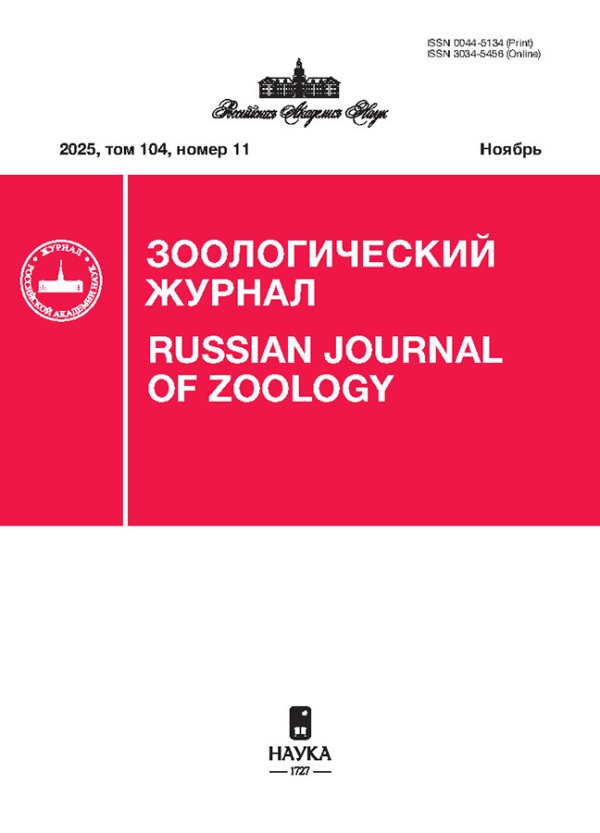Vol 102, No 1 (2023)
ARTICLES
CHANGES IN TESTATE AMOEBA ASSEMBLAGES IN A SERIES OF DIFFERENT-TYPE AQUATIC AND TERRESTRIAL HABITATS OF WETLAND AND FOREST ECOSYSTEMS
Abstract
Patterns of changes in the species richness, abundance, community structure, and biomass of testate amoebae were studied in a series of different-type aquatic and terrestrial habitats along an interlake transect in the Tyumen Region. Altogether, 112 species and forms of testate amoebae, including subspecies, were identified. Micrographs of all species detected are given. The species Conicocassis pontiguasiformis (Beyens et al., 1986) Nasser and Anderson, 2015, previously described as an arctic endemic, was found in the south of Western Siberia for the first time. The species richness of testate amoeba assemblages is maximal in the periphyton. The highest values of species numbers and biomass were detected in the bottom detritus of the coastal part of a swamp lake. Testate amoeba assemblages in various habitats along the transect are divided into aquatic and terrestrial, according to the results of cluster and principal component analyses. The species composition of testate amoeba assemblages depended on substrate wetness, as well as the type of vegetation. The dominants in relative biomass were identified for aquatic, forest, and well-lit Sphagnum habitats.
 3-21
3-21


THE COLD-LOVING ROTIFER, SYNCHAETA LAKOWITZIANA LUCKS 1912 (ROTIFERA, SYNCHAETIDAE), IN LAKE PLESHCHEYEVO, YAROSLAVL REGION, RUSSIA
Abstract
In the deep-water stratified Lake Pleshcheyevo, a cold-water species of rotifer belonging to the “northern invaders”, Synchaeta lakowitziana, was discovered for the first time. The rotifer was recorded in the winter-spring (March–May) and late autumn (November) periods at water temperatures of 1.9–12.9°С. The trophi morphology of the rotifer is described.
 22-26
22-26


Two New Species of Eulohmannia Berlese 1910 (Acari, Oribatida, Eulohmanniidae) From the Russian Far East and Kashmir
Abstract
In surveying material of the genus Eulohmannia Berlese 1910, representatives of two new species were discovered. Eulohmannia aborigensis sp. n., described based on all instars, is known only from alpine environments of the Kolyma Highlands in Magadan Oblast, Russia. It is the largest species of the genus known (length often well over 800 µm) and appears to be bisexual. Adults are unique among the known species of Eulohmannia in having a relatively long femur IV (about 2 times the length of trochanter IV), three setae on trochanter III, 14 setae on tarsus IV, and a minute tooth or spine at the base of each lateral claw. Eulohmannia juvenalis sp. n., described based on adults and a single tritonymph, is known only from forest soil in the Kashmir Valley (Kashmir). Among the known species of the genus, adults are unique in having paedomorphic legs, resulting from several specific neotenic characters. The most conspicuous is a monodactylous pretarsus on all legs and the retention of a single seta on trochanters III and IV, but several other setae are delayed or fail to be developed.
 27-45
27-45


THE TUNDRA SWAN, CYGNUS COLUMBIANUS (ANATIDAE), IN THE EASTERN ASIAN ARCTIC: TRENDS AND RANGES OF DIFFERENT FLYWAY POPULATIONS
Abstract
The tundra of the eastern Asian Arctic is inhabited by at least three flyway populations of the Tundra swan: the East Asian continental migratory flyway population of C. c. bewickii; the western Pacific flyway population of C. c. bewickii, and the western (American) flyway population of C. c. columbianus. The main objective of the present paper is to assess population trends by comparing information on the historical (the only one in the tundra of northeastern Asia) bird aerial survey in 1993–1995 with the data of our aerial survey held in 2020–2021. Another aim was to estimate the proportion of breeding birds in different flyway populations. The size of the zone of intergradation C. c. bewickii and C. c. columbianus in Chukotka and the level of hybridization have so far remained poorly studied, this issue required clarification. Aerial survey data for 2020–2021 were processed using QantumGIS 9.16.5 software. The system included the following layers: a vector layer of the world map; routes of aerial surveys for 2020 and 2021; and polygons of counts for 1993–1995. The system made it possible to calculate the length of the survey. Estimates for each region were calculated for the extrapolation area given in the historical survey. Between 1993–1995 and 2020–2021, an increase in the numbers of all three flyway populations of the Tundra swan was revealed on the breeding grounds. The East Asian continental flyway population increased 3.86 times, vs. 3.05 times for the West Pacific flyway population (while the documented growth of this population was 2.1 times, according to mid-winter counts over the same period). The Western (American) flyway population grew 2.5 times. We believe that the northern border of the summer range of the Tundra swan has significantly shifted to the north, following the summer climate change and the northward shift of the subarctic tundra zone. Registration of nests and broods in areas where only non-breeding birds were recorded during the historical survey is additional evidence of a northward displacement of the range. Kymyneyveem R (about 175.6° W) borders the areas of dominance of C. c. bewickii and C. c. columbianus. The switch in dominance has been triggered off, as there is no zone where both subspecies would occur in equal proportions. The overlap area of both subspecies extends for 600 km along the Arctic coast.
 46-58
46-58


MIGRATORY CONNECTIONS IN WATERFOWL OF NORTHERN WESTERN SIBERIA, BASED ON RING-RECOVERY DATA
Abstract
Migratory connections in waterfowl in the north of Western Siberia are discussed as based on ring recoveries from the database of the Bird Ringing Center of Russia, A.N. Severtsov Institute of Ecology and Evolution of the Russian Academy of Sciences. Altogether, 3531 recoveries from waterfowl of 29 species were used. The waterfowl in the region are characterized by exceptionally wide migratory connections, occurring in different seasons in most regions of the Old World within the Northern Hemisphere: from Iceland to the Japanese Islands and from West Africa to the Indian Subcontinent and the Yangtze River basin. The long-distance flights of birds to molting sites, the interannual change of nesting grounds and wintering regions, as well as the distribution on wintering grounds are discussed. Ten wintering regions have been allocated. The available material on the migration of waterfowl is evaluated from the viewpoint of completing the description of their seasonal distribution and its significance in the study of ecological connections of the territory of Western Siberia.
 59-81
59-81


FORAGING BEHAVIOUR OF THE RED-NECKED STINT (CALIDRIS RUFICOLLIS, SCOLOPACIDAE, CHARADRIIFORMES) DURING THE AUTUMN MIGRATION AT VARIOUS LOCALITIES OF THE RUSSIAN PACIFIC COAST
Abstract
The foraging behaviour of the Red-necked stint (Calidris ruficollis, Scolopacidae, Charadriiformes) was analyzed in detail. The observations were carried out by the authors on the coasts of the Sea of Okhotsk near Magadan and Ola (August 2010), and on Urup Island, Kuriles (August-September 2021, as part of the complex expedition of the second field season “Eastern Bastion – Kuril Ridge”, organized jointly by the Expeditionary Center of the Ministry of Defense of the Russian Federation and the Russian Geographical Society. The diversity of stint species-specific feeding techniques was assessed, and their list compiled, based on a digital coding system. A schematic presentation of the foraging strategies of the Red-necked stint has been proposed.
 82-105
82-105


POPULATION DENSITY OF RESIDENT AND NON-RESIDENT FOREST SMALL MAMMALS
Abstract
When assessing the abundance of small mammals using traditional methods, an abundance index, the number of individuals per unit of trapping effort, is usually applied. Due to the different relationships of species to various traps and baits, the true ratio of species in nature may not coincide with the estimated one. In most cases, the presence of a non-resident component in the population size remains outside the attention of researchers, while dispersal is a key element for many demographic processes. A method is proposed for calculating the density (individuals per area) of resident and non-resident animals when using mark-recapture live-traps arranged in lines. For three mass species of small forest mammals (red-backed voles, common shrew and masked shrew), the dynamics of the density of the resident and non-resident population were studied over 18 years. In most cases, the red-backed vole dominated the population of small mammals. According to long-term average data, the proportion of non-resident individuals in the population of the three species did not differ, averaging 12.6% of the total density. The dependence of the level of non-resident activity in the red-backed vole on the density of resident animals was shown. In shrews, the density of non-residents did not depend on the density of resident ones. The technique allows for a wide range of ecological problems to be solved and it can be used to monitor the state and structure of communities of small mammals.
 106-114
106-114


BRIEF COMMUNICATION
THE FIRST RECORD OF THE SCALLOP, AEQUIPECTEN OPERCULARIS (L. 1758) (MOLLUSCA, PECTINIDAE), IN RUSSIA’S WATERS
Abstract
A juvenile specimen of the scallop, Aequipecten opercularis, was found in 2007 in the eastern part of the Varanger-Fjord, Kola coast of the Barents Sea. The northern range limit of this species has earlier been drawn much more southerly, at the Atlantic coast of Norway. This record is the first in Russia’s waters, probably being related to climate warming in the southern part of the Barents Sea since the early 2000’s.
 115-117
115-117


DISCOVERY OF ALIEN INVADERS IN THE GALLS OF THE DRYOCOSMUS KURIPHILUS HALTWORK (HYMENOPTERA, CYNIPIDAE) IN THE NORTHERN CAUCASUS
Abstract
The Eastern chestnut gall wasp, Dryocosmus kuriphilus Yasumatsu 1951, after having appeared in forests with the participation of the common chestnut in Russia, soon began to cause significant damage. The study of its biology revealed the presence of several insects in its galls, which use them as a new habitat. In fact, the use of galls by alien inhabitants of local chestnut consumers new to aboriginal forest communities has started. The role of these consumers for the eastern chestnut gall washer is currently unknown.
 118-120
118-120












